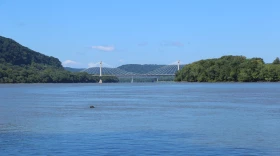New testing confirms three Louisville Gas and Electric power plants are illegally contaminating groundwater flowing into the Ohio River and Herrington Lake.
The pollution is coming from waste sites storing decades worth of ash leftover from burning coal for energy.
Coal ash contains a cocktail of potentially harmful chemicals and is polluting Louisville’s drinking water source, but that pollution has not affected the quality of the city’s drinking water.
“These constituents are getting into the Ohio River, but at concentrations probably equal to what we have in the Ohio River,” said Gary Revlett, LG&E environmental affairs director. “We’re not concerned from a risk standpoint, a [health-risk standpoint.]”
As a result of the violations, the Environmental Protection Agency requires LG&E to close down the waste sites within five years. LG&E is already in process of closing all 19 of its coal ash ponds at a cost of more than $900 million — at no new additional costs to ratepayers.
Earlier this year, WFPL News reported on groundwater pollution at coal-fired power plants owned by LG&E and Kentucky Utilities. Here’s a brief update on the pollution found in the latest round of testing from each of the plants:
Mill Creek – Groundwater monitoring at this plant in southwest Louisville found the cancer-causing pollutant arsenic at 19 times higher than the EPA’s drinking water standards. The coal ash contaminants are present in groundwater that flows to the Ohio River.
E.W. Brown – Groundwater monitoring at the plant near Danville found unpermitted levels of lithium — a neurotoxin — and molybdenum in the groundwater that flows into Herrington Lake.
Ghent – Groundwater monitoring at the Ghent Generating Station northeast of Carrollton found unpermitted levels of lithium and molybdenum in groundwater that flows into the Ohio River.
Trimble – Trimble County Generating Station was initially included, but Revlett said LG&E asked for another round of testing after an engineer found one of the monitoring wells was too close to the ash pond. Subsequent testing did not find levels of pollution high enough to warrant a violation under EPA rules, he said.
Cane Run – Cane Run in southwest Louisville was not included in the original round of groundwater testing, but has recently been added as a result of a federal lawsuit between the EPA and environmental advocates. LG&E is now undergoing a first round of testing on the affected waste sites.
Coal Ash In The Water
One downside to burning coal for energy is the waste it leaves behind. Much of that coal ash has ended up in clay-lined holes in the ground that are covered with water.
Across the country, 91 percent of all coal ash dumps are polluting groundwater, according to a comprehensive study from Earthjustice, an environmental nonprofit.
Last year, utilities in Kentucky released information about the first round of testing. WFPL News analyzed that data that found all 14 power plants covered under EPA rules at that time showed evidence of polluting groundwater.
Now that utilities like LG&E have conducted their final round of testing for most plants, they have to begin closing the plants that violated EPA rules.
“We have collected that data and at some of our sites we are finding statistically significant levels above background,” said Revlett, LG&E’s environmental affairs director.
But Revlett also said those violations need context. The pollution entering waterways is only a small fraction of the total volume of water, he said. Also, the unpermitted pollution is only a small percentage of what utilities are legally allowed to dump in places like Herrington Lake.
“The amount of groundwater is just insignificant compared to what we are allowed to discharge and which is not considered as being an environmental problem based on the permitting done by the state,” Revlett said.
Earthjustice Senior Counsel Lisa Evans doesn’t see it the same way. She said all of that pollution adds up, both permitted and unpermitted.
“These chemicals don’t just disappear when they go into a body of water and they may reappear in forms that are harmful to both aquatic organisms and to humans,” she said.
As for Louisville’s drinking water, the pollution is only a drop in the bucket relative to the billions of gallons of water that pass by the city on the Ohio River everyday. Regardless, Louisville Water Company tests its water for chemical contamination and has not seen any signs of coal ash pollution, said spokeswoman Kelly Dearing Smith.
Cleaning Up Coal Ash Ponds
LG&E has already closed or is in the process of closing 17 of its 19 coal ash ponds, said Scott Straight, project engineering vice president.
The utility actually started the process of closing these ponds in the late 2000’s before the coal ash rules were even finalized. And it has gone above and beyond the regulations to include synthetic liners on all of the ponds where the coal ash will be stored in place.
“At this point all 19 ponds will be completed well within the 2023 timeline,” Straight said.
But capping and closing isn’t always the most effective way to stop groundwater pollution.
Evans with Earthjustice said that if groundwater is moving through the coal ash on its way to a body of water, that cap doesn’t really do anything to stop further pollution.
Climate change is another point of uncertainty. As the potential for flooding increases so does the risk posed to coal ash waste sites close to rivers like the Ohio.
“If you have frequent river rises as we are finding with our increased frequency of storms,” she said. “You can keep having that waste inundated by the water then you can have the contaminants flow out.”
LG&E’s coal-fired power plants that are still in use will continue to use dry storage, like a planned coal ash landfill at the Trimble County Generating Station.
© 2019 89.3 WFPL News Louisville.





